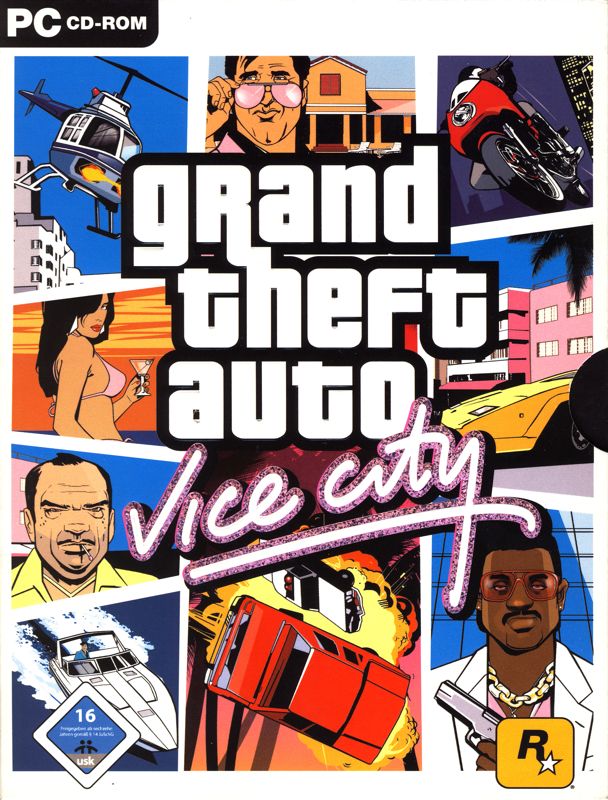When I first slipped into the neon-lit streets of Vice City, it was the early 2000s, and the gaming world was in the midst of a revolution. “Grand Theft Auto: Vice City” was not just a game; it was an experience that transported players into a vibrant, chaotic, and thrilling universe reminiscent of the 1980s. In this retro review, I will revisit this classic title, exploring its impact, gameplay, and what makes it a timeless gem in the gaming community.
The Setting: A Love Letter to the 1980s
Vice City is more than just a fictional locale; it is a tribute to Miami and its vibrant culture during the 1980s. From the pastel colors of the buildings to the synth-heavy soundtrack, every detail immerses players in a world that feels both familiar and fantastical. As I navigated the sun-soaked streets, I was struck by the attention to detail that Rockstar Games poured into the environment.
The game captures the essence of the era, replete with iconic fashion styles, classic cars, and a soundtrack that features a mix of original music and licensed tracks. I often found myself stopping to admire the graphics, which, although dated by today’s standards, still hold a certain charm that contributes to the overall nostalgia.
Storyline: From Rags to Riches
The narrative of Vice City follows Tommy Vercetti, a character who embodies the ambition and grit of the 1980s. After being released from prison, Tommy finds himself embroiled in the criminal underbelly of Vice City, seeking to make a name for himself.
As I progressed through the game, I became engrossed in the intertwining stories of power, betrayal, and ambition. The well-crafted missions kept me engaged, and the character development added layers to the experience. Each main character, from the flamboyant Lance Vance to the ruthless Sonny Forelli, was memorable and contributed to the immersive storytelling.
Gameplay: Freedom and Chaos
One of the standout features of Vice City is its open-world gameplay, a hallmark of the Grand Theft Auto series. I appreciated the freedom to explore the city at my own pace, whether I was engaging in missions or simply cruising along the coastline. The ability to interact with the environment and partake in various activities, such as purchasing properties or engaging in side missions, added depth to the gameplay experience.
The combat mechanics felt refined for the time, with a variety of weapons and vehicles at my disposal. The addition of motorcycles and helicopters provided fresh ways to traverse the city, making each mission feel unique. While there were moments of frustration due to the sometimes clunky controls, the overall experience was exhilarating.
Soundtrack: A Nostalgic Journey
The soundtrack of Vice City deserves special mention. As I cruised through the streets, the radio stations offered a delightful mix of 80s hits that perfectly complemented the game’s atmosphere. From the catchy tunes of Michael Jackson to the smooth sounds of Hall & Oates, the music was a crucial element that enhanced my experience.
The inclusion of original radio hosts and their humorous banter contributed to the immersion. I often found myself laughing out loud at the comedic segments, which provided a nice contrast to the game’s more serious themes.
Visuals: A Retro Aesthetic
Graphically, Vice City was a leap forward for its time, showcasing a vibrant color palette and a richly detailed environment. As I revisited the game, I was reminded of its unique art style. The character models and animations may appear dated compared to today’s standards, but they still evoke a sense of nostalgia.
The lighting effects, particularly during sunset, created a picturesque backdrop that made exploring the city a joy. I enjoyed taking in the views from various vantage points, whether it was from a high-rise building or the beach.
Cultural Impact: A Game That Redefined a Genre
Vice City was not just a commercial success; it left an indelible mark on the gaming industry. Its blend of storytelling, open-world exploration, and immersive gameplay set a new standard for future titles. As I reflected on its legacy, I realized how it paved the way for the modern open-world game design we see today.
The game also sparked conversations around violence in video games and the portrayal of crime. While some critics condemned its themes, many players embraced the freedom it offered, leading to discussions about morality in gaming. This cultural dialogue is part of what makes Vice City a significant title in gaming history.
Conclusion: A Timeless Classic
Revisiting Grand Theft Auto: Vice City was a nostalgic journey that reminded me why this game holds a special place in the hearts of gamers. Its captivating storyline, immersive gameplay, and unforgettable soundtrack come together to create a timeless experience.
For those who played it during its original release, the memories are likely as vivid as ever. For new players exploring the game today, Vice City offers a glimpse into a bygone era filled with charm and chaos. As I put down the controller, I felt grateful for the opportunity to step back into a world that continues to inspire and entertain.
Internal and External Links
For more insights into classic video games, check out our article on The Evolution of Open-World Games.
For a deeper dive into the 1980s culture that inspired Vice City, visit The 1980s: A Cultural Overview.
By revisiting Grand Theft Auto: Vice City, we can appreciate not only its gameplay but also its lasting impact on the gaming landscape. Whether you are a returning player or a newcomer, this classic remains a must-play for anyone interested in the evolution of video games.
<iframe width="560" height="315" src="https://www.youtube.com/embed/BQ69p-libCc?si=V7d9EeRgfbybZk6v" title="YouTube video player" frameborder="0" allow="accelerometer; autoplay; clipboard-write; encrypted-media; gyroscope; picture-in-picture; web-share" referrerpolicy="strict-origin-when-cross-origin" allowfullscreen></iframe>




.jpg?w=100&resize=100,70&ssl=1)
